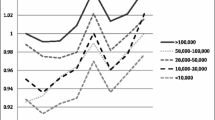Abstract
Despite earlier evidence to the contrary, recent inquiries appear to reach a consensus that the poor pay more for food. However, these studies utilize samples drawn on the basis of prior knowledge of unfair pricing strategies, proximity of volunteer surveyors, or selected by other non-random methods. This paper revisits the issue of price discrimination by analyzing price data collected using a stratified, random sample design to answer the question of whether prices are higher in poor, urban neighborhoods. Contrary to the recent literature, it is found that market prices in poor neighborhoods are not higher than those in more affluent areas.
Similar content being viewed by others
REFERENCES
Alcaly, R., & Klevorick, A. (1971). Food prices in relation to income levels in New York City. Journal of Business, 44, 380-397.
Alwitt, L., & Donley, T. (1996). The low-income consumer. Thousand Oaks, CA: Sage.
Ambrose, D. (1979). Retail grocery pricing: Inner-city, suburban, and rural comparisons. Journal of Business, 52, 95-102.
1966 American Big Business Directory (1996). IL: American Big Business Directories.
Ayres, I. (1991), Fair driving: Gender and race discrimination in new car negotiations. Harvard Law Review, 104, 817-872.
Ayres, I., & Siegelman, P. (1995). Race and gender discrimination in bargaining. American Economic Review, 85, 304-321.
Burdett, K., & Judd, K. (1983). Equilibrium price dispersion. Econometrica, 51, 955-969.
Butters, G. R. (1977). A survey of advertising and market structure. American Economic Review, 66, 392-397.
CensusCD 2.0 (1995). East Brunswick, NJ: Geolytics, Inc.
Chevalier, J. (1995). Capital structure and product-market competition: Empirical evidence from the supermarket industry. American Economic Review, 85, 415-435.
Citro, C. F., & Michael, R. T. (Eds.) (1995). Measuring poverty: A new approach. Washington, DC: National Academy Press.
Consumer Expenditure Survey (1993). Washington, DC: Government Printing Office. United States Department of Labor Statistics, Bulletin 2462.
Darden, W., & Lumpkin, J. (1984). Psychographic and demographic profile of convenience food store users: Why people convenience shop. Review of Business and Economic Research, 19(2), 68-80.
Demographics USA, Zip Edition 1996 (1996). New York: Market Statistics.
Directory of Single Unite Supermarket Operators (1996). Tampa, FL: CSG Information Services.
Directory of Supermarket, Grocery and Convenience Store Chains (1996). Tampa, FL: CSG Information Services.
Finke, M., Chern, W., & Fox, J. (1997). Do the urban poor pay more for food? Issues in measurement. Advancing the Consumer Interest, 9 (1), 13-17.
Geithman, F., & Marion, B. (1993). Testing for market power in supermarket prices: A review of the Kaufman-Handy/ERS Study. In: R. Cotterill (Ed.), Competitive strategy analysis in the food system, pp. 253-291. Boulder, CO: Westview Press.
Glaeser, E. (1998). Should transfer payments be indexed to local price levels? Regional Science and Urban Economics, 28, 1-20.
Goldberg, P. (1996). Dealer price discrimination in new car purchases: Evidence from the Consumer Expenditure Survey. Journal of Political Economy, 104, 622-654.
Graddy, K. (1997). Do fast-food chains price discriminate on the race and income characteristics of an area? Journal of Business and Economic Statistics, 15, 391-401.
Green, M. (1991). The poor more for less. Part I: Grocery shopping. New York: City of New York Department of Consumer Affairs.
Groom, P. (1966). Prices in poor neighborhoods. Monthly Labor Review, 89, 1085-1090.
Kaplow, L. (1995). Regional cost of living adjustments in tax transfer schemes. Cambridge, MA: National Bureau of Economic Research. NBER Working Paper #5008.
Kinsey, J. D. (1998). Concentration of ownership in food retailing: A review of the evidence about consumer impact: St. Paul, MN: University of Minnesota, The Retail Food Industry Center. Working Paper 98-04.
Kunreuther, H. (1973). Why the poor pay more for food: Theoretical and empirical evidence. Journal of Business, 46, 368-383.
Little, R., & Rubin, D. (1987). Statistical analysis with missing data. New York: Wiley.
MacDonald, J., & Nelson, P. (1991). Do the poor still pay more? Food price variations in large metropolitan areas. Journal of Urban Economics, 30, 344-359.
Marion, B., Mueller, W., Cotterill, R., Geithman, F., & Schmelzer, J. (1979). The food retailing industry. New York: Praeger.
Million Dollar Directory (1996). New York: Dun & Bradstreet.
Munnell, A., Tootell, G., Browne, L., & McEneaney, J. (1996). Mortgage lending in Boston: Interpreting HMDA data. American Economic Review, 86, 25-53.
Pratt, J., Wise, D., & Zeckhauser, R. (1979). Price differences in almost competitive markets. Quarterly Journal of Economics, 93, 189-211.
Rothschild, M. (1974). Searching for the lowest price when the distribution of prices is unknown. Journal of Political Economy, 82, 689-711.
Salop, S., & Stiglitz, J. (1977). Bargains and ripoffs: A model of monopolistically competitive price dispersion. Review of Economic Studies, 44, 493-510.
Sexton, D. E. (1971). Comparing the cost of food to blacks and to whites-A survey. Journal of Marketing, 35(3), 40-46.
Sheppard, A. (1991). Price discrimination and retail configuration. Journal of Political Economy, 99, 30-53.
SN Retailers and Wholesalers (1996). New York: Fairchild Books.
Sourcebook of Zip Code Demographics (1996). VA: CACI Marketing Systems.
Supermarket Census (1997). CT: Trade Dimensions.
Troutt, D. (1993). The thin red line: How the poor still pay more. San Francisco, CA: Consumers Union of the US, West Coast Regional Office.
United States Bureau of the Census (1997). Poverty in the United States, 1996. Washington, DC: Government Printing Office.
Varian, H. (1980). A model of sales. American Economic Review, 70, 651-659.
Yinger, J. (1986). Measuring discrimination with fair housing audits: Caught in the act. American Economic Review, 76, 881-893.
Author information
Authors and Affiliations
Rights and permissions
About this article
Cite this article
Hayes, L.R. Are Prices Higher for the Poor in New York City?. Journal of Consumer Policy 23, 127–152 (2000). https://doi.org/10.1023/A:1006421500820
Issue Date:
DOI: https://doi.org/10.1023/A:1006421500820




